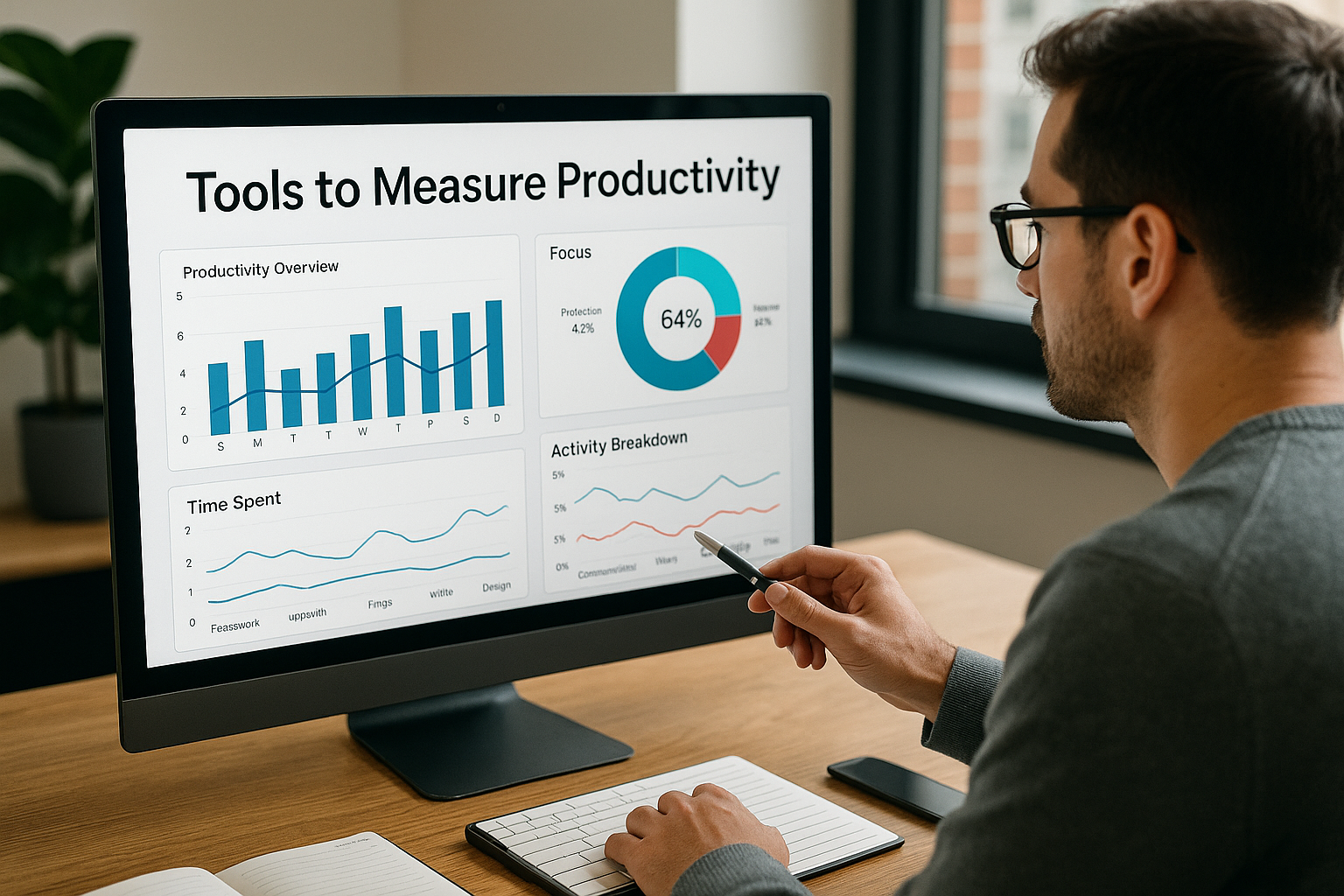Feeling busy but not necessarily productive? These tools to measure productivity will change that.
Whether you’re a solo entrepreneur or managing a team, staying “active” doesn’t always mean you’re achieving real progress. That’s where smart tools to measure productivity come in — they offer clarity, insight, and direction. Instead of guessing where your time goes, you’ll get hard data that reveals what’s working, what’s wasted, and how to fix it. This guide dives into seven of the most impactful options available today.

Why Productivity Data Beats Gut Feeling
Most of us work from intuition — feeling productive because we’re “doing something.” But the reality often tells a different story. Tools to measure productivity replace guesswork with evidence. They break down how time is spent, what distracts you most, and how consistent your focus actually is.
This matters because time blindness is real. We underestimate distractions and overestimate deep work. With accurate data, though, we stop guessing and start adjusting. And those adjustments compound — into better outcomes, smarter routines, and more mental clarity.
Plus, the very act of measurement increases awareness. Just knowing you’re being tracked — even by yourself — nudges you toward more intentional action. It’s accountability, minus the stress.
Choosing the Right Fit for Your Workflow
The best tools to measure productivity aren’t one-size-fits-all. A freelancer managing clients doesn’t need the same dashboard as a remote team of five. That’s why flexibility matters.
If your focus is time tracking, start with Toggl Track or Clockify. If you want deeper attention analytics, go for RescueTime or Focus Booster. Project-heavy teams may prefer ClickUp, while mobile teams thrive on Hubstaff’s GPS and reporting features. Define your workflow first — then match the tool.
And be honest about adoption. The perfect tool isn’t the one with the most features — it’s the one you’ll actually use consistently. Simplicity often wins.
Seeing Patterns That Lead to Change
Once you start collecting data, the real power is in what it reveals. You’ll start seeing trends: when you work best, what derails you, which tasks burn time. That’s when tools to measure productivity become transformation tools.
Maybe you discover Monday mornings are high-output, but afternoons crash. Or that meetings eat 40% of your week. These insights aren’t trivial — they guide decisions about scheduling, delegation, even career direction.
Numbers don’t lie. But they do need interpretation. The best tools show context, not just graphs. They let you tag sessions, label tasks, and compare focus across projects.
Why Simplicity Matters More Than Ever
Over-engineered software becomes another thing to manage. Great tools to measure productivity integrate quietly. They auto-track, sync effortlessly, and let you review with minimal effort. Tools like RescueTime run in the background. Clockify lets you start/stop timers with one tap. Focus Booster simply logs your Pomodoro cycles.
Complexity is the enemy of consistency. If a tool takes 20 clicks to check progress, you’ll stop using it. If it reminds you of goals while working, you’ll keep going. Choose lightweight tools — especially for solo workflows.
Backing Insight with Research and Results
Behavioral psychology supports this approach. According to research on productivity monitoring tools, users who receive regular feedback perform significantly better than those who don’t. It’s the loop that matters: track, reflect, adjust.
The same applies across roles. Whether you’re billing clients or managing a team, consistent measurement leads to smarter decisions. With modern tools to measure productivity, you don’t just optimize time — you sharpen energy, attention, and effort.
Start small. Track one variable. Review weekly. Expand from there. The goal isn’t control — it’s clarity.
Applying It to Your Own Focus System
You don’t need to reinvent your process. Add tools to measure productivity into what you already do. For example, if you already plan in blocks, just track how long those blocks hold. If you journal, reflect on what your tool reveals weekly. Combine data with narrative.
The best approach blends automation with intention. Use tools to measure — but don’t forget to think. For a deeper system, check out our guide to deep work vs. shallow work and build your environment accordingly.
The Quiet Advantage of Awareness
Awareness isn’t glamorous — but it’s powerful. By simply noticing your time patterns, you’ll start shifting them. The more consistent your tracking, the more focused you’ll become. Over time, these micro-adjustments compound into massive wins.
That’s what makes tools to measure productivity so impactful. They don’t shout. They show. They give you perspective and options. And from there, it’s on you — to act, iterate, and improve.
Final Thoughts
Tools to measure productivity are more than timers and graphs — they’re clarity engines. With the right ones, you’ll spend less time guessing and more time doing. Whether you lead a team or run solo, these tools offer the insight to work smarter, recover faster, and grow sustainably. Start now — and let your data lead.
Ready to Take Action?
Start applying these tools to measure productivity strategies today — and unlock your productivity edge.
Explore More on Tools to Measure Productivity
Want to dive deeper? These resources expand your understanding of tools to measure productivity in real-world contexts:

Thank you for the insightful article on productivity tools! Appreciate the clear breakdown and actionable recommendations.
Thank you, Nicky! Glad you found the recommendations useful — we’ll keep sharing more actionable tools to stay focused.